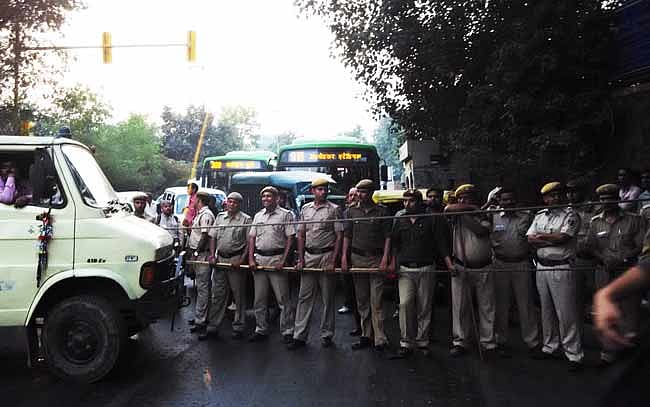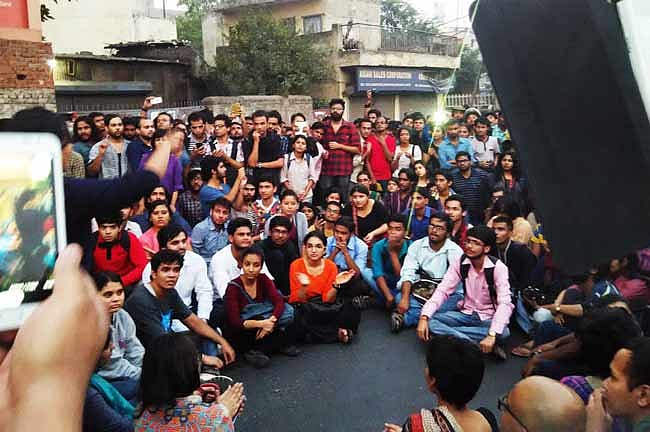Kiss of Love: More Than Just Lip Service
Was Delhi’s Kiss of Love empty symbolism or effective protest? Opposing schools of thought and co-existence.
Section 294 of the Indian Penal Code (IPC), which is often invoked – or at least used as a pretext – by moral policing groups has an uncanny similarity to Section 66 A of the Information Technology (IT) Act. While the former is a Victorian era remnant and the latter a result of Congress’ paranoia; framed as late as 2008, both cite “annoyance” as a possible reason for conviction.

Support Independent Media
The media must be free and fair, uninfluenced by corporate or state interests. That's why you, the public, need to pay to keep news free.
ContributeNow, since annoyance is evidently a legally acceptable argument, how do you live in this country without spending half your time in court and the other half in police stations? Let’s face it, we as a people are never going to all be on the same page and will continue to annoy each other. So how does co-existence happen? Is there enough space in the country for khaki knickers and miniskirts to co-exist? There is no definitive answer and any attempt to address the question with a binary approach will invariably end up being an exercise in both prejudice and futility.
The evening of November 8, in the area around the Jhandewalan metro station in New Delhi, the capital hosted its own version of “Kiss of Love”, provocatively named “Sanghi gunde hoshiyar, tere saamne karenge pyaar” (roughly translates as “Beware Sanghi goons, we’ll make love in front of you”) provided what could possibly be the closest practical laboratory to answer the question.
While the event was officially slated to begin at 4 in the evening, cars – mostly SUVs with black-sheathed windows – began arriving at the designated spot as early as 3.30 pm. Ironically, the early birds weren’t people who were a tad too excited about indulging in some public display of affection. Instead, these were people who had come to protest against the protest. While folks who see their beer mug as half-full would probably attribute their early arrival to the strict discipline that the Sangh imbibes in you, I am a little more sceptical. For, during the course of the evening – and even the previous evening, the Rashtriya Swayamsevak Sangh’s (RSS) supporters displayed very little of that discipline the RSS prides itself on when it came to the facebook page of the event. It was spammed with choicest abuses and threats of physical violence. However, we shall come to that later.
The evening progressed rather uneventfully, presumably to the disappointment of the hordes of cameras and journalists (including the author). For a large part of the evening, there were almost as many journalists as protesters from either side. There was only one major scuffle where an RSS man tried to separate a couple kissing by breaching the human chain formed by the supporters of the Kiss of Love around the duo. It was one of the very few kisses that actually saw the light of day in Delhi’s Kiss of Love.

By around 5:30 pm though, there was a large enough gathering of protesters, journalist and onlookers to create a potential law and order problem.
This is where credit must be given when it’s due. To a set of people who always end up on the wrong side, irrespective of whether people are kissing or pelting stones: the police. The Delhi Police was unprepared, but regrouped quickly and came out looking very good indeed. When protesters started assembling, a beat constable told me that they had no idea this would become so big, but within minutes, senior officials and female cops had arrived at the location to take control of things.
Their effort is all the more commendable because both sides kept accusing them of being soft on the other, but they stuck to their jobs, braving both lack of numbers and jibes from either side.

***********
The anatomy of Delhi’s version of Kiss of Love is not too difficult to deconstruct. Young students primarily from the city’s three most liberal universities – Delhi University, Jawaharlal Nehru University and Ambedkar University – had gathered to lodge their protests against the Sangh’s ways. The Hindutva school of thought inherently contradicts the European liberal ethos the protesters have come to naturalise through academics and course-work.
But as the case is with most protests of this nature, there was a sense of disorganisation that bordered on anarchy. As a Polish journalist present at the protest told me – “This almost seems like two groups of children slugging it out on the playground. It is more confrontational than anything else, almost at the risk of completely undermining an important concept of personal freedom in a diverse country like India. The fact that they chose to organise it near the RSS headquarters instead of a conventional protest spot like Jantar Mantar suggest the idea is only provocative and amateurishly so.”
When I put forward the same question to the protesters, answers varied from defiance to indifference. Agnivesh, who went from describing himself as a “citizen” to a publisher, maintained that there was no politics involved and the choice of the site emanated from recent events where Hindu organisations have resorted to violence in their quest to keep “western influences” at bay. Another young student said that the RSS headquarters was the new 7, Race Course Road, and the choice of the location of the protest was against the institutionalisation of moral policing under the new regime.
This is perhaps when the all-important concepts of space and co-existence come into play. The fact that RSS volunteers arrived in hordes and well ahead of time is telling. It points to an invasion of public spaces and individual personal spaces that the RSS indulges in with alarming frequency. This is evident in the root cause of the Kiss of Love protests: a bunch of goons roughing up a couple in a café. In fact, an informal conversation with most of the conservative RSS supporters at the venue reiterates that. “Where does one draw the line?” is the one question I persist with, asking many people at the protest who sloganeered against western culture. As a cue, I’m even willing to offer suggestions like “Is holding hands okay?” But the argument, in a dogged effort to avoid logic, invariably leads to the much-abused “today they are kissing, tomorrow they’ll have sex inside metro trains” line.
Most neutral observers at the protest conceded that the protests were too symbolic even for a symbolic exercise. However, there is little doubt that the protesters were rightfully claiming co-ownership to a space that they have as much right to as the self-appointed guardians of Indian culture.
The Kiss of Love made a point. That shared common space is as much for the miniskirt as it is for the khaki knicker. As for the murmurs of it being an elitist misadventure executed by carefree students, the protest leveraged exactly that carefree spirit of the youth to translate outrage on social media (which often fizzles out to a new trend as the perpetrators are often more opportunistic than reactionary) into more visible dissent on the streets of the capital.

And if a further reiteration of the Sangh’s masquerading of hooliganism with Indian values and discipline to claim ownership of a space they only co-own was ever needed, I experienced it first hand. I was walking down to the metro station with a young female reporter friend after the protest got over, when one of those many SUVs with dark window glass that had queued up before the protests, stopped and asked us to step inside the car to give them a practical demonstration of Kiss of Love:“Behen ke lodon, car main ghuske kiss of love karo.”
It was hardly past 6, in one of the busiest neighborhoods in the city, and I was too taken aback to respond. She wasn’t though, and lashed out, following which they meekly rolled up the windows and sped away. “Happens everyday – it’s almost part of the job”, she said after having calmed down.

Power NL-TNM Election Fund
General elections are around the corner, and Newslaundry and The News Minute have ambitious plans together to focus on the issues that really matter to the voter. From political funding to battleground states, media coverage to 10 years of Modi, choose a project you would like to support and power our journalism.
Ground reportage is central to public interest journalism. Only readers like you can make it possible. Will you?
